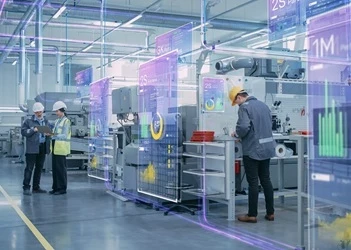BPM Technology - Test and learn (Transcript)
Add bookmarkThe following is a transcript of the audio podcast 'BPM Technology - Test and Learn', to listen to the podcast click here.
Craig Sharp: Hello, and welcome to Process Perspectives, a podcast series produced by the Process Excellence Network. PEX Network is an online and event community for Process professionals. I'm your host, Craig Sharp, Editor of pexnetwork.com.
Coming in today’s programme we're talking to Martin Scovell, CEO of MatsSoft Limited, about the key role technology plays in improving business processes. MatsSoft is an independent software company, established in 2007, and providing BPM solutions to clients in the US and the UK.
Mats, their proprietary IBPM multiplatform solution, has been adopted by a number of large clients by organizations globally, and the company continues to expand.
Martin, welcome, and thank you for joining us today.
Martin Scovell: Thank you very much, Craig, it's nice to be here.
Craig Sharp: I wanted to start, by asking a little bit about your history. I understand you come from a design background, 14 years at a design company. How do you shift from being in such a creative role, having such a creative background, to a process driven and analytical mindset, and can creativity flourish in the process excellence role?
Martin Scovell: Yes, a very interesting question. That's absolutely right; I did run a design business, a marketing business, for quite a few years. I'm actually a marketing person by education and background, and moved into agency life what seems like many years ago now, and we grew an agency, and got more and more involved in financial services customers, and more of that type of activity led us down the line to look at process driven solutions, to issues like applying for a mortgage or managing customer experience, and things of that sort, so it was a natural progression, really, to move from a creative background into a background that brought creativity into solving business solutions and business problems, and so today MatsSoft is a software business, as you rightly said in the introduction, and MatsSoft came from the agency, and was set up as a separate business as a result of that side of the business growing.
I exited the agency itself in 2012, and focus wholly on the MatsSoft business now, and my personal belief, and I think it's a widely held belief, is that the merging of creativity and technology is a very natural progression that's empowered by mobility and an increasingly discerning and educated consumer base, and so it is very natural for these to come together, and also that's also that's powered by the ability to do things at a much smaller and lower cost level than previously might have been the case. I read a statistic the other week that suggested that the chief marketing officer in a business might have a bigger technology budget than the IT director in future years. I don’t know whether, when that horizon is likely to come about, but it does seem a logical progression.
Craig Sharp: It seems like a logical progression to me, as well. You said it was a natural progression towards MatsSoft; do you feel your position with the previous company, marketing to financial companies gave you a unique perspective when it came to developing a BPM solution?
Martin Scovell: I think it gave us a perspective. I wouldn’t necessarily say unique, but I would say perhaps coloured and textured by all the experiences that we, as a team, had, and our background was about trying to solve communications issues with customers, to win and retain customers, using a whole basket of different techniques, a lot of it driven by creativity, be it graphical or intellectual creativity, or even commercial creativity, and indeed, using technology, and as I said earlier, it's a natural coming together of all these different strands to empower people to innovate and to collaborate, and technology is the underlying background that allows that to happen in a way, which is quick, measurable and meaningful.
Craig Sharp: How important is technology in process excellence? What would you say to companies who are reluctant to adopt newer technologies?
Martin Scovell: I would say, please have another look at it. There are lots of things happening out in the world at large, from a technological perspective, which we can't do much to influence, but we can do a lot to leverage to help solve problems and deliver good solutions, and it strikes me that if technology is an enabler to do that, and process underlies pretty much everything that happens in any business, if you can reach down into a business at the very smallest level, and have a meaningful and standardised way of defining, and then automating and enacting processes, that means that the whole business benefits from a viewpoint that looks at every single thing that they do in a standardised way, which can only mean better quality, more engagement with the staff, and team members and other stakeholders, and ultimately a better experience for the customer, which is top of the priority for all businesses, as we know.
Craig Sharp: As an extension of that, process excellence in BPM, particularly in the technology space, is rife with technical jargon, complex ideas and notions. How do you ensure that practices and methodologies are kept user friendly, and easy to understand for people, perhaps, who don’t come from that background?
Martin Scovell: Again, a good question. It is sometimes a bit of a minefield. I'm a non-technical person. As I say, I'm a marketing person. I absorb the acronyms and the practices and the various jargons there, and try to make sense of them in a way which is meaningful. I think ultimately it's a matter of saying how do we make these things work in a way which people can see and measure, so it sort of places it in a separate level from the technology and the jargon itself.
I think the challenge that faces all of us in the industry is to find ways of making the whole idea of process excellence less austere and less IT driven, and more about using technology to engage with people and customers, and let people collaborate, so they gain an emotional ownership over the processes that they're helping to define, and put into practice and automate, because they’ve got some hands on capability to do it, and I think one of the real enablers of that is the ability to deliver very low cost, very easy to use, user configurable solutions out of the cloud, which allow people to test, learn and experiment, and get things wrong, but do so in a way which they can learn from, and then gain some genuine ownership of when they roll it out as a tried and tested solution.
There ought to be the climate and the culture created to say that we can bring small groups of people together who work in a department, who use various processes, be it formally or informally, and we help them, and give them the tools to understand and redefine what they do, and look for ways of improving it.
Craig Sharp: You mentioned emotional ownership for the team using these technologies. What advice and suggestions can you give to people who want staff to feel like they own these technologies throughout the company?
Martin Scovell: I think it rests on a number of different things. Going back to one of the points I mentioned a little earlier. It's about trying to find a standardised approach that reaches into all parts of the business, so there aren’t any lines drawn across the business that say, if a project isn't this big, or with this much budget, or this much resource we can't do it, or we'll just leave you to use an Excel spreadsheet, or something like that. There ought to be the climate and the culture created to say that we can bring small groups of people together who work in a department, who use various processes, be it formally or informally, and we help them, and give them the tools to understand and redefine what they do, and look for ways of improving it.
It's a process, which has got a permission-to-fail badge on it, which means that because they're not burning lots of resources and budget on these things, you can let people experiment, get things wrong occasionally, and out of that comes an ownership, which means that there's a lot more compliance and a lot more willingness to use these processes, because they’ve had a hand in creating and improving them.
If you can do that across an entire business, from the very largest processes with maybe thousands of users, right down to the departmental level, you have a cultural shift, which means that your business can start looking outwards, and thinking about customer improvement, customer experience, gains, retaining customers and being more competitive, and using your resources better, rather than having a whole basket of different and often competing ways of trying to solve processing problems, which ultimately drive your business.
Craig Sharp: Okay. And finally, just one last question for you, Martin, kind of building on that slightly, there may be some people listening to this who are looking to embark on a new BPM project, who are finding it tough getting internal buy in from decision makers. Investment, the technological jargon that we mentioned previously, there could be a number of reasons that could be. Have you got any suggestions for those change agents who are facing that kind of push back?
Martin Scovell: Yes. I think, for a start, look to try to build a business case, from even small amounts of data, so you can start to actually define the problem that you're trying to solve, the issue you're trying to address, and that means that you then have something to improve upon from a business perspective, as well as just an operational perspective.
In terms of getting buy in, a lot of the technologies available now, which are cloud delivered and quick and easy to use; they're, you can talk to people in Operations who have actually got problems, the problems they solve day-to-day, and build something that proves a case before you need to engage with larger budget holders or with risk and security or IT in general, which means you're a long way down the line to proving your business case before you actually need to go and look for these larger resources, so you have a way of addressing these things at the level of the problem itself rather than looking for sponsorship to solve a class of issue, shall we say?
Craig Sharp: So pilot studies and test cases can be key for this kind of company change?
Martin Scovell: Absolutely, yes.
Craig Sharp: Okay thank you very much Martin. That's all from us here today, at the Process Excellence Network, but as always, don’t forget that for additional process related resources, including podcasts, articles, webinars and more, log on to pexnetwork.com. Martin, once again, thank you for joining us.
Martin Scovell: Thanks for the time. Thank you.
MatsSoft's client Nationwide Building Society - is one of the case study presentations featured at our free online event, BPM Open House this September. Visit the website for more information.




















